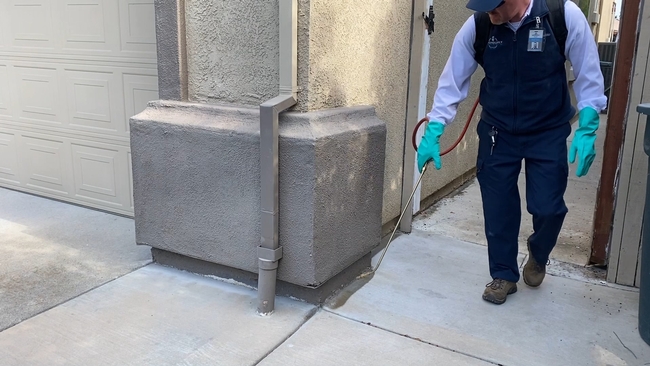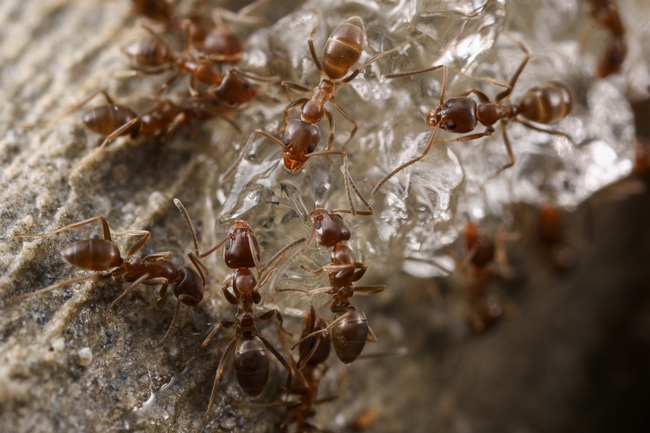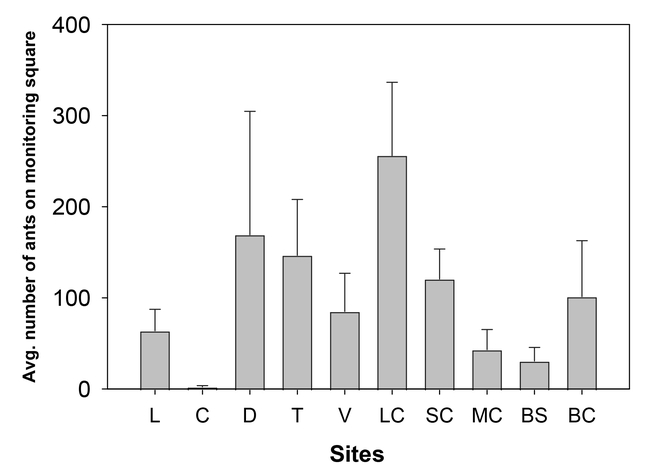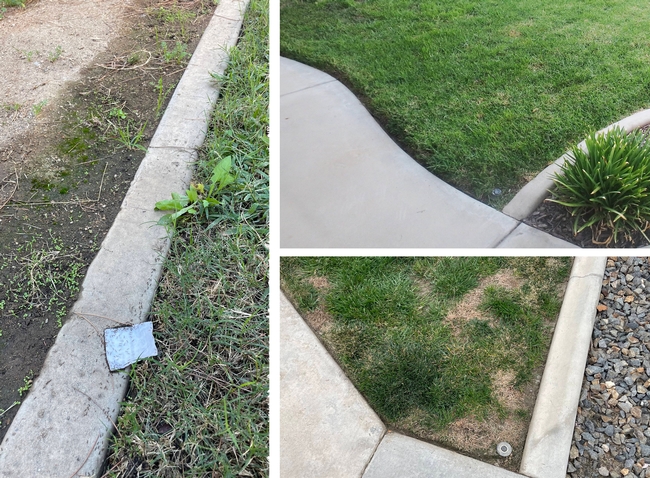Ants are one of the major seasonal pests around structures in California's urban environments. Pest management companies throughout the state report that ants are responsible for a significant proportion of their pest control services. In urban residential areas of California, the Argentine ant, Linepithema humile, is the most common nuisance ant species treated by pest management professionals (PMPs) as well as the public themselves (Figure 1).

While contact insecticides are frequently used to control Argentine ants, they also contribute to environmental contamination via drift and runoff. However, insecticide applications following California's recent regulatory changes and label updates may fail to control target pest ants consistently potentially resulting in repeated insecticide applications (Choe et al. 2021).
Baiting for ant control
Baiting (Figure 2) can reduce the need for insecticide spray applications. Active incorporation of baits in a management program may help to lower the risk of environmental contamination caused by insecticide drift and run-off. For Argentine ants, which often form large colonies with multiple nest sites and reproducing queens, the initial application of perimeter spray would still be needed to provide a quick knockdown of foraging ant populations during peak season (June or July). However, baits are particularly useful for subsequent maintenance visits (monthly or bimonthly). In fact, baiting has been demonstrated to be an effective tool for maintenance services for Argentine ants (see References).
Many bait products are available for professional use, and when strategically used, they can be effective at keeping ant numbers low (at acceptable levels) following the initial spray treatment. Gel / liquid / granular bait products containing boric acid, indoxacarb, and thiamethoxam are effective for Argentine ant control.

Importance of bait placement
If PMPs choose to incorporate baits as a main tool for maintenance visits, there is an important question to be answered: Where to place the bait? Unless bait stations are already installed in specific locations and periodically serviced (e.g., cleaning and refilling), PMPs must determine where the baits need to be applied during their visit.
Unlike insecticide sprays, the ants must consume the bait to be effective. Baits placed in just any location cannot be expected to work. Strategic placement of baits is critical to maximize the bait consumption by foraging ants and control of the pest ant populations. In fact, baits start losing their palatability (attractiveness as food) from the moment they are applied in the environment.
Since all ant foragers are liquid feeders, keeping the bait hydrated (minimal water loss) is vital to maximize bait consumption. Contamination and degradation might also impact bait palatability over time. Placing baits in the areas where the ants are currently traveling or foraging will ensure maximum bait consumption. Baits are typically more expensive than insecticide sprays (based on the product cost to treat a unit area), so strategic placement of baits is also crucial from an economic standpoint.
Label information on bait products usually includes specific tips regarding bait placement. For example, one commercial ant bait product label states, “place bait on, into, or adjacent to structures where ants are observed, adjacent to ant trails and to areas suspected of ant activity.” Another product's label instruction states, “locate areas around the building where ants are seen trailing. Apply [the bait] in areas inaccessible to children and pets. For a perimeter defense system, place bait stations near the foundation or where ant trails are found.” In essence, these instructions require knowledge of the locations where the ants are currently active or likely will be within a day or two.
Finding ant trails might be easy if customers have already observed or reported the ant infestation. However, finding active ant trails could be time-consuming, and time for careful inspection to discover active ant trails around the structure during a service visit is often limited.
Ant trail location study
Is there a quick and reliable way to identify the most likely places where Argentine ants would trail and forage in residential outdoor settings? Knowing this would make it possible to quickly determine the best sites for bait placement without looking for ant trails. Argentine ants are known to rely on chemical signals (trail pheromone) as well as structural features (structural guidelines) when maneuvering in the environment (Klotz et al. 1997). Many residential settings share some common structural features such as concrete, lawn, mulch, plant, and soil. If common features can be used to reliably locate the foraging ant trails, that could reduce the time needed to look for ant trails during bait applications.
| Site types | Surface/characteristics |
|---|---|
| L | Lawn |
| C | Concrete |
| D | Dumpster/trashcan |
| T | Tree |
| V | Vegetation/bush |
| LC | Lawn – concrete interface |
| SC | Soil – concrete interface |
| MC | Mulch – concrete interface |
| BS | Building (vertical surface) – soil interface |
| BC | Building (vertical surface) – concrete interface |
A simple field experiment was designed to identify the best sites for bait placement. The study was conducted in October on the University of California, Riverside campus. Several site types were identified based on structural characteristics. Five of these site types were characterized by the presence of a single surface type or a single characteristic item—lawn (L), concrete (C), dumpster or trashcan (D), tree (T), vegetation/bush (short plant without trunk, V). Five other site types were characterized by the presence of two surface types and the interface between them – lawn and concrete (LC), soil and concrete (SC), mulch and concrete (MC), building and soil (BS), and building and concrete (BC). The list of site types is provided in Table 1.
The experiment was replicated 5-13 times for each of the site types. Small squares of cotton (monitoring squares) soaked in 25% (wt:wt) sucrose solution were placed in these sites. The monitoring squares were collected after one hour, and Argentine ants on the cotton squares were counted. The number of ants on the monitoring square was used as the quantitative indicator for ant foraging activity.
The overall data suggest the interface between lawn and concrete (LC) was the location with the highest level of Argentine ant foraging activity (Figure 3). The interface between lawn and concrete (LC) had a much higher number of ants than its single-surface counterparts (L, lawn only or C, concrete only). Bases of the tree (T) and dumpster site (D) also had a good amount of ant activity, but there can be significant amounts of variation in ant activity, especially for dumpster sites (i.e., hit-or-miss). Open concrete surface (C) had the lowest level of foraging activity. Lawn (L), vegetation/bush (V), and four other interface types (SC, MC, BS, and BC) showed intermediate levels of ant activity.

Certain structural and landscape features can be used to quickly determine the best locations for inspection and bait (liquid or gel) placement against Argentine ants. Interfaces between lawns and concrete are among the most common structural features of residential outdoor settings. For example, they are found between lawns and various concrete surfaces, such as driveways, sidewalks, patios, and landscape curbing (Figure 4).
There are possible reasons why the Argentine ants prefer to trail along the interface between lawn and concrete. Preferred microclimate conditions (moisture, temperature) may exist in that location. The absence of heavy vegetation along the lawn and concrete interface (ease of travel), but still with some level of protection (partially shaded), may also be preferred by trailing ants. Environmental factors such as relatively high humidity and partial protection from direct sunlight would also be advantageous in keeping the liquid or gel bait palatable for extended periods.
Take-home message
It is vital to effectively manage pest ants in urban environments with minimal impacts on human health and the environment. To help reduce our reliance on repeated application of insecticide spray products, baiting should be considered for maintenance service visits for pest ants. To maximize the impact of baiting, the baits should be placed along lawn and concrete surfaces. Of course, a control program should not rely only on baiting but also be supplemented with non-chemical techniques such as exclusion, sanitation, removal of honeydew sources, and water management.
It is important to note that the information and data discussed in this article are focused on Argentine ants and sugar-based bait products targeting this species. Thus, the information may or may not directly apply to other ant species with different feeding habits, foraging strategies, or population structures.
For more information about ant management, see the UC IPM Ant page https://ipm.ucanr.edu/PMG/invertebrates/links.ants.html.
References cited
Choe D-H, Paysen, E, Greenberg L, Campbell K, Rust MK. 2019. A closer look: Argentine ant control. Pest Control Technology. GIE Media, Inc. p. 130-135. Vol. 47. No. 10.
Choe D-H, Tay J-W, Campbell K, Park H, Greenberg L, Rust MK. 2021. Development and demonstration of low-impact IPM strategy to control Argentine ants (Hymenoptera: Formicidae) in urban residential settings. J. Econ. Entomol. 114: 1752–1757.
Klotz JH, Greenberg L, Shorey HH, Williams DF. 1997. Alternative control strategies for ants around homes. J. Agric. Entomol. 14: 249-257.
[Originally featured in the Spring 2024 edition of the Green Bulletin Newsletter for structural and landscape pest professionals.]
